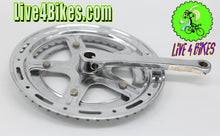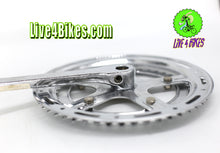
"Embrace Vintage Vibes: The 10-Speed Steel 3-Piece Crankset Cotter Type"
Introduction
Cycling enthusiasts often have a soft spot for classic and vintage bikes. If you're looking to restore or maintain the authenticity of your 10-speed road bike, the 10-Speed Steel 3-Piece Crankset Cotter Type is a key component to consider. In this article, we will explore the charm of this vintage-style crankset and why Live4Bikes is the perfect place to source such classic components.
The Allure of Vintage Biking
Vintage bicycles have a unique charm that transcends time. The allure of a retro ride is not just about nostalgia; it's also about experiencing the craftsmanship and design of an era when cycling was about simplicity and elegance. The 10-Speed Steel 3-Piece Crankset with a cotter type design embodies this vintage charm, making it a sought-after component for classic bike aficionados.
Key Features of the 10-Speed Steel 3-Piece Crankset Cotter Type
-
Cotter-Type Design: Cotter-type cranksets were commonly used on classic bicycles, making them an iconic feature of vintage rides. This design provides a distinctive appearance and reflects the historical evolution of cycling components.
-
Steel Construction: The crankset is built from durable steel, ensuring long-lasting performance and maintaining the aesthetic of classic bicycles. Steel is renowned for its strength and ability to withstand the test of time, which is vital for vintage bike restoration.
-
3-Piece Construction: The 3-piece crankset consists of the left crank arm, the right crank arm, and the chainring. This design allows for easy disassembly and maintenance, an important consideration for vintage bike owners who want to preserve their rides.
Why Choose Live4Bikes for Your Vintage Components
-
A Niche for Classic and Vintage Enthusiasts: Live4Bikes understands the passion and enthusiasm of classic and vintage bike owners. Their inventory includes a variety of components that cater to these unique interests, making it a hub for enthusiasts looking to restore and maintain their classic rides.
-
Expert Guidance and Customer Service: Live4Bikes employs a team of experts who are well-versed in classic and vintage cycling components. They can guide you through the selection process, ensuring you find the right components for your classic bike restoration project.
-
Competitive Pricing: Live4Bikes offers competitive prices, providing excellent value for classic and vintage cycling components. This affordability is crucial for those who want to stay true to their vintage ride without breaking the bank.
-
Easy and Secure Online Shopping: Live4Bikes provides the convenience of online shopping, allowing you to browse their range of classic and vintage components and make purchases from the comfort of your home. Their secure online ordering system ensures a smooth and hassle-free shopping experience.
Conclusion
The 10-Speed Steel 3-Piece Crankset Cotter Type captures the essence of vintage cycling and is a cherished component for classic bike enthusiasts. When it comes to purchasing classic and vintage cycling components, Live4Bikes is the go-to destination for those who appreciate the history and heritage of cycling. With their extensive inventory, expert staff, competitive pricing, and convenient online shopping, you can confidently embrace the charm of vintage biking and experience the joys of classic bicycle restoration.
- More Crank info
- DIY TIPS
- Minimize Windows
Understanding Bicycle Cranks: Types, Sizes, and Materials
Introduction
Bicycle cranks are a crucial component of a bike's drivetrain, responsible for transferring the rider's pedaling force to the chainring, which in turn propels the bicycle forward. In this article, we'll explore the various types of bicycle cranks, different sizes available, and the materials they are constructed from.
Types of Bicycle Cranks
-
Square Taper Cranks:
Square taper cranks are a traditional design, characterized by a square-shaped spindle that fits into the bottom bracket. They have been a standard for many years, known for their simplicity and durability. However, they are becoming less common with the rise of newer technologies.
-
Octalink Cranks:
Shimano introduced the Octalink system, which features eight splines on the crank arm that interface with a matching bottom bracket. Octalink cranks are known for their increased stiffness and power transfer compared to square taper cranks.
-
ISIS Drive Cranks:
ISIS (International Splined Interface Standard) drive cranks use a splined interface between the crank arm and the bottom bracket spindle. This design was intended to improve stiffness and durability, but it has been largely replaced by newer standards.
-
External Bearing Cranks:
External bearing cranks, also known as Hollowtech II (by Shimano) or GXP (by SRAM), use outboard bearings that sit outside of the bottom bracket shell. This design provides increased stiffness and weight savings.
-
Direct Mount Cranks:
Direct mount cranks have become popular in recent years, especially in the mountain biking community. They attach directly to the spindle, eliminating the need for a separate chainring spider. This design allows for a wider range of chainring sizes and improved stiffness.
Different Sizes of Bicycle Cranks
-
Crank Arm Length:
Crank arm length is measured from the center of the bottom bracket spindle to the center of the pedal spindle. Common lengths range from 165mm to 180mm. Shorter crank arms can provide a more aerodynamic position and are favored by some cyclists, while longer crank arms may offer more leverage for powerful pedaling.
-
Chainring Sizes:
The size of the chainring(s) on the crankset can significantly affect the bike's gearing. Smaller chainrings provide easier pedaling but lower top speeds, while larger chainrings offer higher top speeds but require more effort to pedal.
Materials Used in Bicycle Cranks
-
Aluminum:
Aluminum cranks are lightweight, relatively inexpensive, and offer good stiffness. They are popular in entry-level and mid-range bicycles.
-
Carbon Fiber:
Carbon fiber cranks are known for their exceptional strength-to-weight ratio. They offer excellent stiffness and can help reduce overall weight, making them popular among high-end and performance-oriented cyclists.
-
Steel:
Steel cranks are durable and cost-effective but tend to be heavier than aluminum or carbon fiber options. They are commonly found on budget-friendly and commuter-oriented bikes.
-
Titanium:
Titanium cranks strike a balance between weight, strength, and durability. They are relatively lightweight and offer excellent corrosion resistance, making them a premium choice for some cyclists.
Conclusion
Choosing the right bicycle crank is essential for optimizing your riding experience. Consider factors like the type of riding you'll be doing, your personal preferences, and your budget when selecting a crankset. Understanding the different types, sizes, and materials available will help you make an informed decision that suits your specific cycling needs.
```Comprehensive Guide to Removing a Square Taper Bicycle Crank
Tools Needed:
- Crank puller tool (compatible with square taper cranks)
- Allen wrench or socket wrench set
- Bottom bracket tool (if necessary)
- Grease (optional)
- Rag or cloth (to clean and wipe parts)
Step-by-Step Guide:
-
Prepare Your Workspace:
Start by finding a clean, well-lit area to work. Lay down a rag or cloth to catch any dirt or small parts that may fall.
-
Gather Tools:
Ensure you have all the necessary tools listed above.
-
Prepare the Bike:
If you have a derailleur, shift the chain onto the smallest chainring to provide easier access to the crankset. If you have a single-speed or fixed-gear bike, you don't need to worry about this step.
-
Remove the Crank Bolts:
Use an Allen wrench or socket wrench to loosen and remove the bolts that hold the crank arms onto the bottom bracket spindle. There are usually two bolts, one on each side.
-
Use the Crank Puller:
Insert the inner part of the crank puller tool into the bottom bracket spindle. Make sure it's threaded securely. Then, thread the outer part of the tool into the crank arm threads. Tighten the outer part of the crank puller tool until the crank arm starts to come off the spindle.
-
Remove the Crank Arm:
Continue to turn the crank puller until the crank arm comes off the spindle. Be sure to support the crank arm with your hand as it comes free to avoid it falling and potentially damaging the ground or other components.
-
Repeat for the Other Side:
If you're removing both crank arms, repeat steps 4-6 for the other side.
-
Inspect and Clean:
Take this opportunity to inspect the bottom bracket and crankset for any signs of wear or damage. Clean the spindle and bottom bracket shell if necessary.
-
Reassembly (if needed):
If you're replacing the crankset or performing maintenance, this is the time to install the new one. Apply a thin layer of grease to the square taper interface before attaching the new crank arms.
-
Tighten Everything Securely:
Ensure that all bolts and nuts are properly tightened to the manufacturer's specifications. Over-tightening can cause damage, so use a torque wrench if available.
-
Test the Crankset:
Spin the crankset to ensure there's no wobbling or unusual resistance. Check that the chain moves smoothly across the chainrings.
Remember to always refer to your specific bike's manufacturer recommendations and specifications, as there may be slight variations in the process depending on the make and model. If you're unsure or uncomfortable with any step, consider seeking help from a professional bike mechanic.







